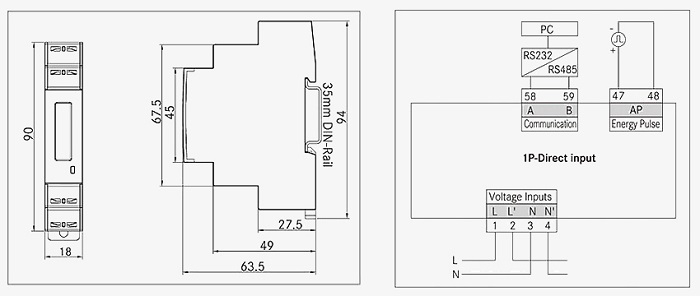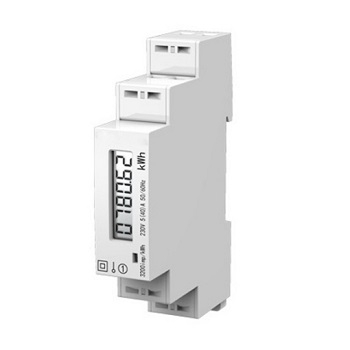An energy meter, also known as an electricity meter or watt-hour meter, is a device used to measure and record the consumption of electrical energy in residential, commercial, and industrial settings. It is an essential tool for utilities and customers alike to monitor and manage electricity usage and accurately calculate billing. sisco shop tells you more details about energy meters.
Working Principle
An energy meter is an electrical instrument used to measure electrical energy, and its working principle is based on the induction of magnetic fields. The main components of the energy meter include a current coil, voltage coil, iron core, turntable, counting mechanism and so on.
When a current passes through a current coil, it creates a magnetic field, the size of which is proportional to the size of the current. At the same time, when alternating current passes through the voltage coil, an alternating electric field is generated, and the size of this electric field is proportional to the size of the historical pressure. Due to the presence of the iron core, the magnetic and electric fields of the current coil and the voltage coil will affect each other, resulting in a magnetic flux inside the iron core. The magnitude of this magnetic flux is proportional to the magnitude of the current and voltage.
The turntable is the core part of the energy meter, which can be rotated under the action of a magnetic field. When the energy meter is connected to the power supply, the turntable will rotate with the change of current and voltage, so as to achieve the measurement of electric energy. The measurement results are recorded and displayed by the counting mechanism.
In short, the working principle of the energy meter is based on the induction principle of the magnetic field, using the magnetic field and electric field generated by the current coil and the voltage coil to interact, so that a magnetic flux is generated inside the iron core, so as to achieve the measurement of electric energy.

Different uses
- Billing and Payment: Energy meters are essential for calculating the amount of electricity consumed by a customer and generating accurate bills. This is the most common and fundamental use of energy meters in utility companies.
- Energy Management: Energy meters help customers and facilities monitor their electricity consumption, enabling better management of energy usage and costs. By tracking energy consumption patterns, users can implement strategies to reduce energy consumption and lower their electricity bills.
- Tariff Calculation: Energy meters are used to calculate the cost of electricity consumption based on the applicable tariff rates. Different tariffs may apply to residential, commercial, and industrial customers, and meters ensure accurate billing according to these rates.
- Load Profiling: Energy meters provide load profiles that show how energy consumption varies throughout the day. This information is valuable for utilities in managing peak demand and for customers in optimizing their energy usage.
- Revenue Protection: Energy meters play a role in revenue protection by detecting tampering or unauthorized connections. If someone tries to manipulate or bypass the meter, it can be detected through irregular readings or alarms.
- Remote Reading: Modern energy meters, particularly smart meters, allow for remote reading of consumption data. This reduces the need for manual meter readings and provides real-time data to utilities and customers.
- Prepaid Metering: Some energy meters, often used in prepaid electricity systems, enable customers to pay in advance for electricity. Customers can monitor their balance and recharge their accounts as needed.
- Renewable Energy Integration: Energy meters are used in situations where renewable energy sources like solar panels are connected to the grid. They measure energy generation and can track net consumption or energy export to the grid.
- Environmental Monitoring: Monitoring energy consumption is also valuable for environmental purposes. It can encourage energy efficiency and the reduction of carbon emissions by helping customers and facilities identify areas where energy can be conserved.
- Data Collection and Analysis: Energy meters, especially smart meters, provide detailed data that utilities can analyze to understand and plan for energy demand, distribution, and infrastructure improvements.
Types of Meters
- Analog Meters: Traditional meters with rotating disks or dials that display energy consumption.
- Digital Meters: Modern electronic meters that display consumption digitally, often with advanced features. Our shop can supply you with this product, such as a three-phase digital energy meter with LCD display.
 Smart Meters: Advanced digital meters with communication capabilities for remote monitoring and data collection.
Smart Meters: Advanced digital meters with communication capabilities for remote monitoring and data collection.
Importance
- They accurately measure and record energy consumption for billing, ensuring fairness and accountability.
- They help customers manage their energy use, identify patterns, and optimize their electricity consumption to reduce costs.
- Utilities rely on energy meters for load forecasting, demand management, and infrastructure planning.
- They contribute to energy conservation and environmental sustainability by promoting responsible energy use.
Energy meters play a pivotal role in the functioning of utility companies, ensuring accurate billing, load management, and responsible energy use. They are essential tools for both utility providers and consumers in monitoring and managing electricity consumption.

